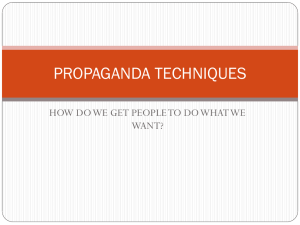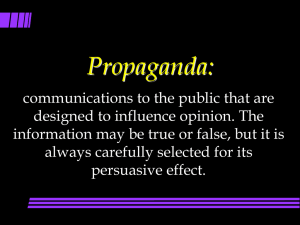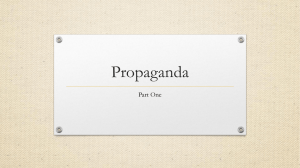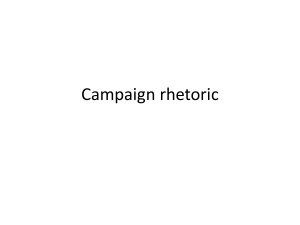Propaganda Student Notes Mrs. Bjornson 9th Grade Literature
advertisement
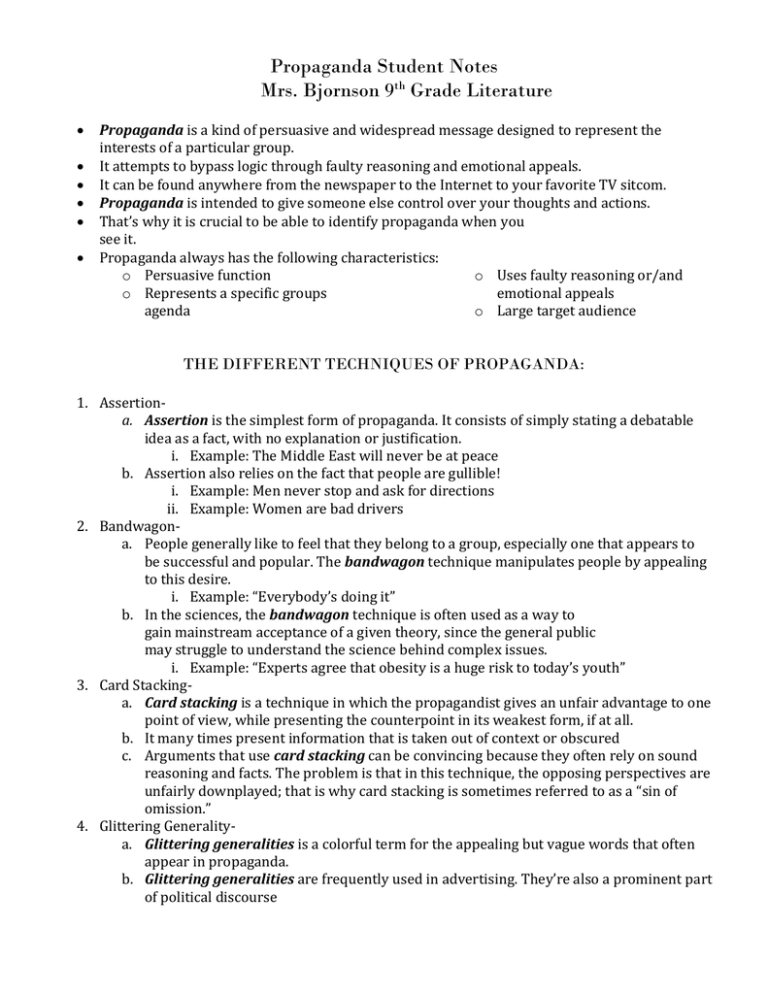
Propaganda Student Notes Mrs. Bjornson 9th Grade Literature Propaganda is a kind of persuasive and widespread message designed to represent the interests of a particular group. It attempts to bypass logic through faulty reasoning and emotional appeals. It can be found anywhere from the newspaper to the Internet to your favorite TV sitcom. Propaganda is intended to give someone else control over your thoughts and actions. That’s why it is crucial to be able to identify propaganda when you see it. Propaganda always has the following characteristics: o Persuasive function o Uses faulty reasoning or/and o Represents a specific groups emotional appeals agenda o Large target audience THE DIFFERENT TECHNIQUES OF PROPAGANDA: 1. Assertiona. Assertion is the simplest form of propaganda. It consists of simply stating a debatable idea as a fact, with no explanation or justification. i. Example: The Middle East will never be at peace b. Assertion also relies on the fact that people are gullible! i. Example: Men never stop and ask for directions ii. Example: Women are bad drivers 2. Bandwagona. People generally like to feel that they belong to a group, especially one that appears to be successful and popular. The bandwagon technique manipulates people by appealing to this desire. i. Example: “Everybody’s doing it” b. In the sciences, the bandwagon technique is often used as a way to gain mainstream acceptance of a given theory, since the general public may struggle to understand the science behind complex issues. i. Example: “Experts agree that obesity is a huge risk to today’s youth” 3. Card Stackinga. Card stacking is a technique in which the propagandist gives an unfair advantage to one point of view, while presenting the counterpoint in its weakest form, if at all. b. It many times present information that is taken out of context or obscured c. Arguments that use card stacking can be convincing because they often rely on sound reasoning and facts. The problem is that in this technique, the opposing perspectives are unfairly downplayed; that is why card stacking is sometimes referred to as a “sin of omission.” 4. Glittering Generalitya. Glittering generalities is a colorful term for the appealing but vague words that often appear in propaganda. b. Glittering generalities are frequently used in advertising. They’re also a prominent part of political discourse i. Example: I stand for freedom—for a strong nation, unrivaled in the world. My opponent believes we must compromise on these ideals, but I believe they are our birthright. 5. False Dilemmaa. The false dilemma is a popular technique used in propaganda. This fallacy is known by many names, including “black-and-white thinking,” “false dichotomy,” and “false choice.” i. Example: One product always works, and the other doesn’t ii. Example: If you aren’t using Tide, your clothes aren’t clean! 6. The Lesser of Two Evilsa. While most false dilemmas offer a “good” and a “bad” alternative, the lesser of two evils technique is a specific type of false dilemma that offers two “bad” alternatives. b. This is used when people are reluctant to accept a viewpoint i. Example: Candidate Mike might cheat on his wife, but at least he doesn’t steal as well! 7. Name- Callinga. Name-calling is the use of negative words to disparage an enemy or an opposing view. Insulting words are used in place of logical arguments, appealing to emotions, rather than reason. b. It appeals to prejudices rather than logic i. Example: John is just your average right-wing gun nut. 8. Pinpointing the Enemya. Propagandists often oversimplify complex problems by pointing out a single cause or a single enemy who can be blamed. b. When the enemy in question is blamed for problems not caused by them, they are know as the scapegoat. i. Example: The Jews were responsible for loosing WWII. 9. Plain Folka. People tend to distrust those they perceive as outsiders, and the plain-folk technique takes advantage of this instinct. b. In this approach, the propagandist makes him or herself appear more like an “insider” in order to gain the public’s confidence. i. Example: Former President Ronald Reagan was often photographed chopping wood. 10. Testimonialsa. Testimonials are a form of propaganda that is familiar to nearly everyone. Almost everything that is advertised comes with some sort of testimonial, from music to hair gel to politicians. i. Example: An Olympic gold medalist claims that she eats Golden Flakes every morning. 11. Transfera. Also known as “association” and “false connection,” transfer is closely related to the testimonial technique. b. In this method, the propagandist encourages the transfer of feelings and associations from one idea, symbol, or person to another. i. Example: An automobile manufacturer that wants to be known as environmentally friendly films its car being driven through a pristine forest. Friendly forest animals eagerly look on—and do not run away—as the car passes. ii. Example: A candidate for office addresses allegations of wrongdoing in front of a house of worship while wearing a religious symbol on his lapel pin.


